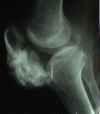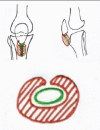Differential diagnosis of BPOP arising in relation to patella
- PMID: 27299085
- PMCID: PMC4845450
- DOI: 10.13107/jocr.2250-0685.331
Differential diagnosis of BPOP arising in relation to patella
Abstract
Introduction: Solitary exostosis is common at the metaphysis of long bones, and rarely may it develop in the lower pole of the patella. Usually it stops growing after skeletal maturity unless complicated. When the growth continues after skeletal maturity, other rare possibilities need to be considered such as bizarre parosteal osteochondromatous proliferation (BPOP). Though solitary exostosis is common at the metaphysis of long bones, very rarely it also develops in lower pole of the patella. Usually they stop growing after skeletal maturity unless complicated. When it starts after skeletal maturity and continues to grow, other rare possibilities like bizarre parostealosteochondromatousproliferation (BPOP) are to be thought of.
Case report: 21 years male student presented with anterior midline painless progressive swelling over right knee joint of one year duration which was hard, non-tender, fixed to patella but mobile with patella. X ray showed midline heterogeneously radio-opaque swelling attached to inferolateral aspect of the anterior surface of patella. Patellar out line is fully maintained except the narrow site of tumour attachment. After exposing through midline incision, the swelling was found to incorporate the patellar tendon completely and an anterior vertical midline cleavage was found. The mass was deliberately detached along the cleavage and from intact patellar tendon. Almost full range of knee movement is obtained in operation table. Immediate post operative 10° quadriceps lag was corrected with quadriceps setting exercises in two weeks time. Histopathological examination demonstrated thin layer of cartilage cover, irregular lamellar bone in deeper zone and spindle cells between them without cytoplasmic atypia. Plenty of cartilage cells in different stages of maturation are seen without column formation. Marrow elements are absent. Periosteum could not be demonstrated and there was no other evidence of malignancy. Features simulate 'bizarre parosteal osteochondromatous proliferation'. There is no recurrence in five years of follow up.
Conclusion: When exostosis like lesions arise from unusual site and at an unusual age group, other rare conditions need to be investigated. Though the final diagnosis of BPOP is obtained after careful histo-pathological examination, the clinico-radiological findings are also relevant. As literature search indicates, this is possibly second incidence where BPOP arised from sesamoid bone and first from patella.
Keywords: BPOP; Bizarre parosteal osteochondromatous proliferation; Osteochondroma; Patella.
Conflict of interest statement
Conflict of Interest: Nil
Figures





Similar articles
-
Bizarre parosteal osteochondromatous proliferation: an educational review.Insights Imaging. 2023 Jun 19;14(1):109. doi: 10.1186/s13244-023-01455-0. Insights Imaging. 2023. PMID: 37336832 Free PMC article. Review.
-
Bizarre parosteal osteochondromatous proliferation (Nora's lesion): a retrospective study of 12 cases, 2 arising in long bones.Hum Pathol. 2002 Dec;33(12):1205-10. doi: 10.1053/hupa.2002.130103. Hum Pathol. 2002. PMID: 12514790
-
Bizarre parosteal osteochondromatous proliferation (Nora's lesion) affecting the distal end of the ulna: a case report.BMC Musculoskelet Disord. 2016 Mar 16;17:130. doi: 10.1186/s12891-016-0981-3. BMC Musculoskelet Disord. 2016. PMID: 26984018 Free PMC article.
-
BPOP in early childhood following resection of osteochondroma: report of a case.Emerg Radiol. 2024 Jun;31(3):435-438. doi: 10.1007/s10140-024-02231-3. Epub 2024 Apr 23. Emerg Radiol. 2024. PMID: 38652206
-
Bizarre parosteal osteochondromatous proliferation: case report and review of the literature.Pediatr Dev Pathol. 2001 Sep-Oct;4(5):496-500. doi: 10.1007/s10024001-0048-8. Pediatr Dev Pathol. 2001. PMID: 11779053 Review.
Cited by
-
Bizarre Parosteal Osteochondromatous Proliferation (Nora Lesion): A Narrative Review.Acta Med Litu. 2022;29(2):176-193. doi: 10.15388/Amed.2022.29.2.4. Epub 2022 Jun 29. Acta Med Litu. 2022. PMID: 37733437 Free PMC article. Review.
References
-
- Singh J, James SL, Kroon HM, Woertler K, Anderson SE, Jundt G, Davies AM. Tumour and tumour-like lesions of the patella--a multicentre experience. EurRadiol. 2009;19(3):701–12. - PubMed
-
- Enriquez J, Quiles M, Torres C. A unique case of dysplasia epiphysealishemimelica of the patella. ClinOrthopRelat Res. 1981;160:168–171. - PubMed
-
- Araujo CR, Jr, Montandon S, Montandon C, Teixeira KISS, Moraes FB, Moreira MAR. DysplasiaEpiphysealisHemimelica of the Patella. Radiographics. 2013 Mar-Apr;:33.
-
- Maurer HJ. Symmetrical osteocartilaginousexostoses (osteochondroma) of the patella. FortschrGebRontgenstr Nuklearmed. 1963;98:771–772. - PubMed
Publication types
LinkOut - more resources
Full Text Sources
Research Materials
